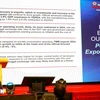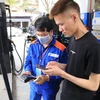A 30 trillion VND (nearly 1.5 billion USD) package to shore up the real estate sector was announced in mid-May this year. Some 70 percent of the package will be provided as loans to low-income earners who want to purchase houses at low interest rates of about 6 percent per year.
As appealing as these loans should be for people with low incomes, the disbursement of these loans is taking place slowly: indeed, for the first 6 months, slightly more than 1 percent of the loans had been granted to borrowers.
Viet Nam News spoke to Dang Hung Vo, Dr., Prof. at Hanoi National University, former Deputy Minister of Natural Resources and Environment; Tran Nhu Trung, Deputy Director of Savills Hanoi; and Doan Phuc, Deputy Director of Agribank Da Nang, about the loan program.
* The 30 trillion VND (nearly 1.5 billion USD) package was announced in mid-May, with many low-income earners hoping to receive loans to purchase apartments from social housing projects. Yet, slightly more than 1 percent of the package has been distributed in the last six months. Why is this so?
- Dang Hung Vo: The Government's support is allocating budget to commercial banks to lend money to low-income earners. I think the main impediment is that the lending mechanism is using procedures that should be applied to high-income earners. These rules require borrowers to show certifications of collateral assets and the ability to pay their debts. Low-income earners, however, can only prove that they hope to have assets in the future after they purchase a home through a contract with the housing projects investors – but it's very difficult for them to prove their ability to pay debts: if they can prove this, they would not be poor any more!
In other countries, they use another mechanism: the community guarantee mechanism. The community of low-income earners, together with social organisations, will manage and act as guarantors for low-income earners when they need to borrow loans.
Also, borrowers will have to provide proof of income. In Vietnam we're still using cash as the main payment method, thus we can't provide proof of people's incomes.
Moreover, borrowers will also have to provide proof of their housing condition – to be more particular, a certificate that they don't currently own housing area smaller than 8 sq.m per capita. This is complicated, as well, because the current housing ownership management system does not allow us to do this. Local authorities will surely hesitate to provide such certifications because they don't have any way to verify if someone has already owned housing property in an area out of their management authority.
In general, we don't have enough tools to determine who would be the right beneficiaries of this package, while those who are really in need of such support have many difficulties in providing required documents.
- Tran Nhu Trung: I, myself, highly applaud the idea of the stimulus package: instead of protecting those without difficulties, the package aims at supporting those in need, those who are more vulnerable than others.
But the twist in the tale here is the conflict between the idea and the implementation of the package. The Government wants to do a good thing for a good cause and not for profits: helping low-income earners. Yet, in the execution process it asks banks, who operate for profit, to provide the loans. With such conflicts existing, I don't think the initial idea can be realised.
Such conflicts resulted in an obvious consequence: complicated procedures for borrowers, a thousand questions, of which none is easy to answer. Who can determine the term "low income"? Who can determine if someone owns or does not own an estate property?
* In recognition of such impediments, the Government has recently issued a new circular to ease some of the procedures for borrowers, such as they only need to provide proof of income in case banks require this, or that local authorities have to certify if some one does not own housing property in the area they manage. Do you think such releases will speed the disbursement of the loans?
- Dang Hung Vo: I don't think so. Such releases in the requirements would otherwise result in things we don't want. We might not be able to provide loans to those who do have low incomes, or those who are really vulnerable and need the Government's support. Even those who are not low-income earners would be able to borrow from the package.
The new regulations have not been able to tackle the main problem: lending money to low-income earners must be different from lending to high-income earners. The requirement on the ability to pay debts is still the toughest part for borrowers. Borrowers still have to provide proofs of income if banks require this - while I'm sure banks will still require such proof in order to protect themselves from bad debts. I think we have to change the lending mechanism of banks involved in the disbursement of the stimulus package.
- Tran Nhu Trung: Even with the recent instruction, which is deemed more open, I don't think it is any easier for low-income earners to borrow loans from this package, because it has not addressed the main problem: the conflict between non-profit and profit.
It's time to face it: there are many things that the Government needs to do for the cause of social welfare. But the Government can't do everything and it can't do everything for free. And it's not a good choice for Vietnam's economy at the current time. Once the economy has developed to a certain level, we just can't drive it the way we want, we have to respect its own operation, especially free market operations.
* So what do you think can be done for this package to fulfill its mission in not only shoring up the real estate sector, but also providing necessary support to low-income earners?
- Dang Hung Vo: We can set a longer period of time for the disbursement of the package, maybe to 20 years.
Also, a change in the requirement of proving the ability to pay debts is needed. The reality is that many countries prove that lending money to low-income earners is a difficult task, but there are many successful models. A bank in Bangladesh has been very successful in lending money to poor people: borrowers don't need to provide proof of collateral assets.
For long-term solution, we should give good opportunities and needed rights to the poor so that they area able to escape poverty themselves.
- Tran Nhu Trung: I think we need to rewrite the axiom: We do have social welfare policies, but we must accept the rules of a market economy. The goal is to support the vulnerable group, but using tools of the market, not the tools of politics.
My idea is that we can support borrowers based upon the value of the housing properties. For instance, if you want to buy an apartment costing 400 million VND (19,000 USD), you can borrow at the interest rate of 0 to 3 percent per month, while if you want to borrow 500 million VND (23,000 USD), the interest rate would be 4 percent. The more you want to borrow, the higher interest rate you will have to accept. This ladder takes into account market elements.
This method will be comprehensive: we respect the rule of the market economy, while we can still classify borrowers based on the amount of their loans.
The issue of social housing, or housing for low-income earners, is a difficult question for many countries. However, in many developed countries, they have a different approach. They know what they can do and what they can't. For low-income earners, they don't think of housing property ownership, they think of renting, as well as renting with government subsidies.
- Doan Phuc: Two branches of Agribank in Da Nang city have provided loans to 61 individuals. Most of these are governmental and military staff - who have stable incomes and can prove that.
We have been able to provide loans to more customers in comparison to other banks, thanks to the goodwill of Da Nang city authorities. The People's Committee has been very enthusiastic and determined in bringing these loans to people who need them. The committee has requested authorities at the grassroots level provide necessary certifications in order to facilitate the borrowing process.
For instance, the city authority requests that grassroots authorities certify if someone does not have housing assets in the area that they manage, without the need to know if they have housing assets in other areas. The city also requests that low income certifications be granted to those earning less than 9 million VND (428 USD) per month.
Though such certifications might not be legally accepted by many banks, we have been more flexible because we can't wait until the Government issues a legal framework to lend money to people who need it right now.
For a long-term perspective, I think we will need a legal lobby for the term "future established housing property". Because, currently, borrowers can only take the future housing property that they buy as collateral assets when required by banks, but many notary offices don't provide services for such terms.
- Tran Ha (in Hanoi): I first worked with a branch of Vietinbank. Initial procedures were fine, but when it came to the 3-party contract among the bank, the investor of my future housing property and me, the bank did not accept the contract form provided by my investor.
I switched to another bank - the Bank for Investment and Development of Vietnam (BIDV). Here, the bank didn't accept the certification of my housing condition, which said I was staying in my parents' house.
I reached out for another branch of Vietinbank - and finally this time they accepted both the 3-party contract and the housing condition certification that my local authority gave me.
But I was wondering why banks are so different in interpreting the Government's instruction? Even branches of a bank are different from each other - like the two branches of Vietinbank that I worked with, as one accepted the 3-party contract and one did not.
Moreover, the local authority at my residency area said they knew nothing about the Government's instruction on providing such certificates for people.
I happen to know many people, from a friend working at a bank, to people working for the local People's Committee where I am living. That helped me a lot in completing the necessary procedures and finally being able to borrow an amount of money from a bank. But what about low-income earners who know nobody?.-VNA
As appealing as these loans should be for people with low incomes, the disbursement of these loans is taking place slowly: indeed, for the first 6 months, slightly more than 1 percent of the loans had been granted to borrowers.
Viet Nam News spoke to Dang Hung Vo, Dr., Prof. at Hanoi National University, former Deputy Minister of Natural Resources and Environment; Tran Nhu Trung, Deputy Director of Savills Hanoi; and Doan Phuc, Deputy Director of Agribank Da Nang, about the loan program.
* The 30 trillion VND (nearly 1.5 billion USD) package was announced in mid-May, with many low-income earners hoping to receive loans to purchase apartments from social housing projects. Yet, slightly more than 1 percent of the package has been distributed in the last six months. Why is this so?
- Dang Hung Vo: The Government's support is allocating budget to commercial banks to lend money to low-income earners. I think the main impediment is that the lending mechanism is using procedures that should be applied to high-income earners. These rules require borrowers to show certifications of collateral assets and the ability to pay their debts. Low-income earners, however, can only prove that they hope to have assets in the future after they purchase a home through a contract with the housing projects investors – but it's very difficult for them to prove their ability to pay debts: if they can prove this, they would not be poor any more!
In other countries, they use another mechanism: the community guarantee mechanism. The community of low-income earners, together with social organisations, will manage and act as guarantors for low-income earners when they need to borrow loans.
Also, borrowers will have to provide proof of income. In Vietnam we're still using cash as the main payment method, thus we can't provide proof of people's incomes.
Moreover, borrowers will also have to provide proof of their housing condition – to be more particular, a certificate that they don't currently own housing area smaller than 8 sq.m per capita. This is complicated, as well, because the current housing ownership management system does not allow us to do this. Local authorities will surely hesitate to provide such certifications because they don't have any way to verify if someone has already owned housing property in an area out of their management authority.
In general, we don't have enough tools to determine who would be the right beneficiaries of this package, while those who are really in need of such support have many difficulties in providing required documents.
- Tran Nhu Trung: I, myself, highly applaud the idea of the stimulus package: instead of protecting those without difficulties, the package aims at supporting those in need, those who are more vulnerable than others.
But the twist in the tale here is the conflict between the idea and the implementation of the package. The Government wants to do a good thing for a good cause and not for profits: helping low-income earners. Yet, in the execution process it asks banks, who operate for profit, to provide the loans. With such conflicts existing, I don't think the initial idea can be realised.
Such conflicts resulted in an obvious consequence: complicated procedures for borrowers, a thousand questions, of which none is easy to answer. Who can determine the term "low income"? Who can determine if someone owns or does not own an estate property?
* In recognition of such impediments, the Government has recently issued a new circular to ease some of the procedures for borrowers, such as they only need to provide proof of income in case banks require this, or that local authorities have to certify if some one does not own housing property in the area they manage. Do you think such releases will speed the disbursement of the loans?
- Dang Hung Vo: I don't think so. Such releases in the requirements would otherwise result in things we don't want. We might not be able to provide loans to those who do have low incomes, or those who are really vulnerable and need the Government's support. Even those who are not low-income earners would be able to borrow from the package.
The new regulations have not been able to tackle the main problem: lending money to low-income earners must be different from lending to high-income earners. The requirement on the ability to pay debts is still the toughest part for borrowers. Borrowers still have to provide proofs of income if banks require this - while I'm sure banks will still require such proof in order to protect themselves from bad debts. I think we have to change the lending mechanism of banks involved in the disbursement of the stimulus package.
- Tran Nhu Trung: Even with the recent instruction, which is deemed more open, I don't think it is any easier for low-income earners to borrow loans from this package, because it has not addressed the main problem: the conflict between non-profit and profit.
It's time to face it: there are many things that the Government needs to do for the cause of social welfare. But the Government can't do everything and it can't do everything for free. And it's not a good choice for Vietnam's economy at the current time. Once the economy has developed to a certain level, we just can't drive it the way we want, we have to respect its own operation, especially free market operations.
* So what do you think can be done for this package to fulfill its mission in not only shoring up the real estate sector, but also providing necessary support to low-income earners?
- Dang Hung Vo: We can set a longer period of time for the disbursement of the package, maybe to 20 years.
Also, a change in the requirement of proving the ability to pay debts is needed. The reality is that many countries prove that lending money to low-income earners is a difficult task, but there are many successful models. A bank in Bangladesh has been very successful in lending money to poor people: borrowers don't need to provide proof of collateral assets.
For long-term solution, we should give good opportunities and needed rights to the poor so that they area able to escape poverty themselves.
- Tran Nhu Trung: I think we need to rewrite the axiom: We do have social welfare policies, but we must accept the rules of a market economy. The goal is to support the vulnerable group, but using tools of the market, not the tools of politics.
My idea is that we can support borrowers based upon the value of the housing properties. For instance, if you want to buy an apartment costing 400 million VND (19,000 USD), you can borrow at the interest rate of 0 to 3 percent per month, while if you want to borrow 500 million VND (23,000 USD), the interest rate would be 4 percent. The more you want to borrow, the higher interest rate you will have to accept. This ladder takes into account market elements.
This method will be comprehensive: we respect the rule of the market economy, while we can still classify borrowers based on the amount of their loans.
The issue of social housing, or housing for low-income earners, is a difficult question for many countries. However, in many developed countries, they have a different approach. They know what they can do and what they can't. For low-income earners, they don't think of housing property ownership, they think of renting, as well as renting with government subsidies.
- Doan Phuc: Two branches of Agribank in Da Nang city have provided loans to 61 individuals. Most of these are governmental and military staff - who have stable incomes and can prove that.
We have been able to provide loans to more customers in comparison to other banks, thanks to the goodwill of Da Nang city authorities. The People's Committee has been very enthusiastic and determined in bringing these loans to people who need them. The committee has requested authorities at the grassroots level provide necessary certifications in order to facilitate the borrowing process.
For instance, the city authority requests that grassroots authorities certify if someone does not have housing assets in the area that they manage, without the need to know if they have housing assets in other areas. The city also requests that low income certifications be granted to those earning less than 9 million VND (428 USD) per month.
Though such certifications might not be legally accepted by many banks, we have been more flexible because we can't wait until the Government issues a legal framework to lend money to people who need it right now.
For a long-term perspective, I think we will need a legal lobby for the term "future established housing property". Because, currently, borrowers can only take the future housing property that they buy as collateral assets when required by banks, but many notary offices don't provide services for such terms.
- Tran Ha (in Hanoi): I first worked with a branch of Vietinbank. Initial procedures were fine, but when it came to the 3-party contract among the bank, the investor of my future housing property and me, the bank did not accept the contract form provided by my investor.
I switched to another bank - the Bank for Investment and Development of Vietnam (BIDV). Here, the bank didn't accept the certification of my housing condition, which said I was staying in my parents' house.
I reached out for another branch of Vietinbank - and finally this time they accepted both the 3-party contract and the housing condition certification that my local authority gave me.
But I was wondering why banks are so different in interpreting the Government's instruction? Even branches of a bank are different from each other - like the two branches of Vietinbank that I worked with, as one accepted the 3-party contract and one did not.
Moreover, the local authority at my residency area said they knew nothing about the Government's instruction on providing such certificates for people.
I happen to know many people, from a friend working at a bank, to people working for the local People's Committee where I am living. That helped me a lot in completing the necessary procedures and finally being able to borrow an amount of money from a bank. But what about low-income earners who know nobody?.-VNA



















